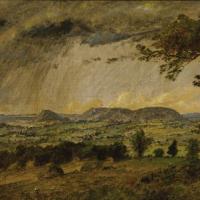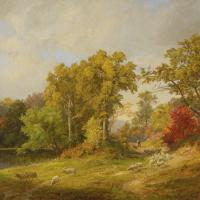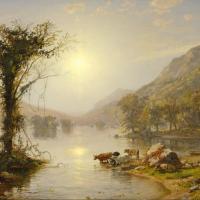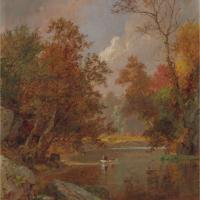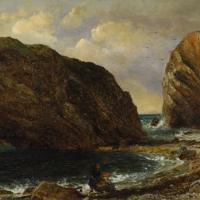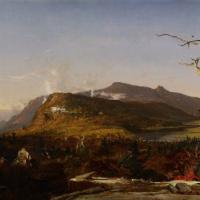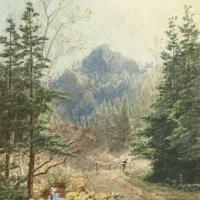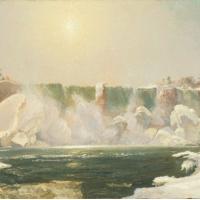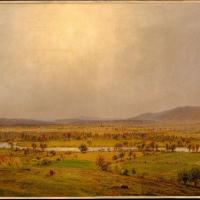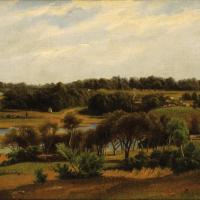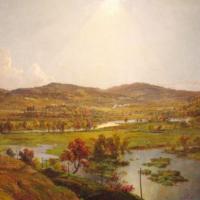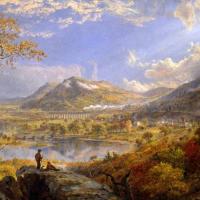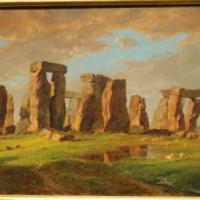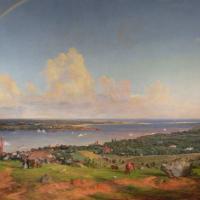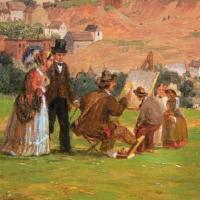Jasper Francis Cropsey
Autumn On Greenwood Lake
$450.00
Autumn On The River
$450.00
By The Sea Lulworth
$450.00
Catskill Mountain House
$450.00
Greenwood Notch
$450.00
Niagara Falls In Winter
$450.00
Pompton Plains
$450.00
Rural Landscape
$450.00
Starrucca Viaduct
$450.00
Stonehenge
$450.00
Jasper Francis Cropsey
Jasper Francis Cropsey (1823-1900)
Jasper Francis Cropsey (February 18, 1823 – June 22, 1900) was an important American landscape artist of the Hudson River School.
Cropsey was born on his father Jacob Rezeau Cropsey's farm in Rossville on Staten Island, New York, the oldest of eight children. As a young boy, Cropsey had recurring periods of poor health. While absent from school, Cropsey taught himself to draw. His early drawings included architectural sketches and landscapes drawn on notepads and in the margins of his schoolbooks.
Trained as an architect, he set up his own office in 1843. Cropsey studied watercolor and life drawing at the National Academy of Design under the instruction of Edward Maury and first exhibited there in 1844. A year later he was elected an associate member and turned exclusively to landscape painting; shortly after he was featured in an exhibition entitled "Italian Compositions".
Cropsy traveled in Europe from 1847–1849, visiting England, France, Switzerland, and Italy. He was elected a full member of the Academy in 1851. Cropsey was a personal friend of Henry Tappan, the president of the University of Michigan from 1852 to 1863. At Tappan's invitation, he traveled to Ann Arbor in 1855 and produced two paintings, one of the Detroit Observatory, and a landscape of the campus. He went abroad again in 1856, and resided seven years in London, sending his pictures to the Royal Academy and to the International exhibition of 1862.
Returning home, he opened a studio in New York and specialized in autumnal landscape paintings of the northeastern United States, often idealized and with vivid colors. Cropsey co-founded, with ten fellow artists, the American Society of Painters in Water Colors in 1866.
Cropsey's interest in architecture continued throughout his life and was a strong influence in his painting, most evident in his precise arrangement and outline of forms. But Cropsey was best known for his lavish use of color and, as a first-generation member from the Hudson River School, painted autumn landscapes that startled viewers with their boldness and brilliance. As an artist, he believed landscapes were the highest art form and that nature was a direct manifestation of God. He also felt a patriotic affiliation with nature and saw his paintings as depicting the rugged and unspoiled qualities of America.
Jasper Cropsey died in anonymity but was rediscovered by galleries and collectors in the 1960s. Today, Cropsey's paintings are found in most major American museums, including the National Gallery of Art, the Metropolitan Museum of Art, the Los Angeles County Museum of Art, the Crystal Bridges Museum of American Art, the Detroit Institute of Arts, the Timken Museum of Art in San Diego, the Honolulu Museum of Art, the Fine Arts Museum of San Francisco, the Denver Art Museum, the Princeton University Art Museum, and the Museum of Fine Arts, Boston. Works by Cropsey also hang in the White House. Cropsey and his wife Maria are buried in Sleepy Hollow Cemeteryin Sleepy Hollow, New York.
Some of his works include Jedburgh Abbey; Pontaine Marshes (1847); Backwoods of America (1857); Richmond Hill (1862); Indian Summer (1866); Greenwood Lake (1870); Lake Nemi in Italy (1879); Old Church at Arreton, Isle of Wight (1880); Ramapo Valley (1881); Autumn on the Hudson (1860): Wawayanda Valley (1883); Spring-time in England (1884); October in Ramapo Valley(1885); Autumn on Lake George, and A Showery Day (1886).
His architectural works included Manhattan brownstones, the since-demolished 14th Street station for the IRT Sixth Avenue Linein Manhattan, and St. Luke's Episcopal Church on Staten Island.
Some of Cropsey's painting command high prices at auctions. Greenwood Lake (1879) sold at Christie's auction in 2012 for $422,500. Sunset, Camel's Hump, Lake Champlain (1877) sold for $314,500 in 2011.
Cropsey's home and studio, Ever Rest, in Hastings-on-Hudson, New York, has the largest permanent collection of Cropsey's work, collected by great-granddaughter Barbara Newington. The collection has been on display since 1977 and the founding of the Newington-Cropsey Foundation.


